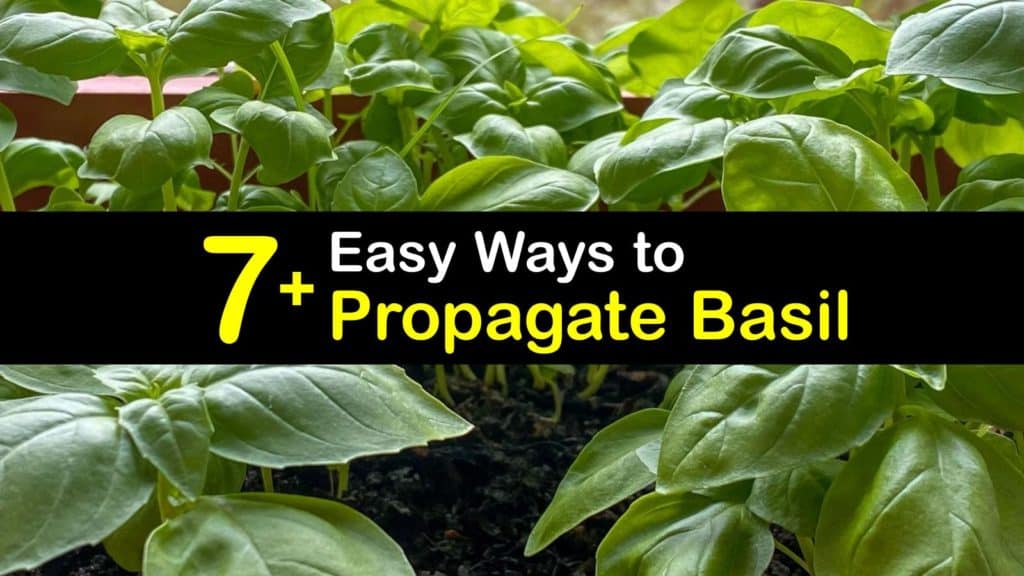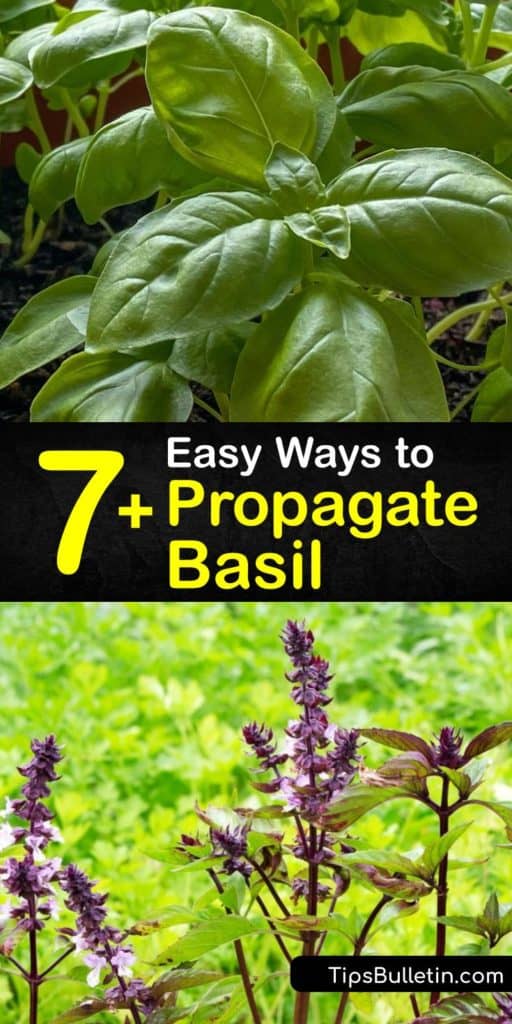Basil is one of the most well-loved herbs for home gardeners. It’s easy to grow and also to regrow from cuttings. In this article, you’ll learn how to propagate basil in several different ways and how to keep it thriving in your kitchen herb garden.
If you’ve ever tried planting the live basil plants from the grocery store, you may have been frustrated that they don’t live very long. They’re actually many different basil plants growing in one root ball and quickly become overcrowded.
It’s possible to divide them and grow them separately into larger, healthy basil plants. The end of the summer season doesn’t have to mean the end of your supply of fresh herbs.

Basics of Basil Propagation
Read on to discover how to regrow basil from cuttings and enjoy an endless supply of fresh basil leaves all year long. All you need is a clean, sharp set of pruners or scissors, a sunny windowsill, and a glass of water.
It’s surprisingly easy to propagate basil cuttings, whether you are dealing with Thai basil vs basil. Although using rooting hormone is beneficial, it’s not necessary. Basil cuttings develop roots from nodes at the base of the stems. Basil is also remarkably easy to grow from seed.
If you enjoy making pesto sauce, tomato basil soup, Thai dishes, or other recipes that require large amounts of basil at a time, it’s handy to keep a supply of basil plants growing in your kitchen herb garden.
By propagating cuttings from a mother plant, you’ll get more bang for your buck when you purchase a basil plant from a garden center or plant nursery.
It’s also a great way to keep a few different basil varieties on hand, like Genovese, Thai, and holy basil. Discover the difference between sweet basil and holy basil and know what to use when cooking. You’ll even be able to share cuttings with your friends and family.
How to Propagate Basil from Cuttings
You don’t necessarily have to be an experienced gardener to successfully propagate basil from cuttings. The process is straightforward, and the results are satisfying.
If you don’t already have a basil plant growing at home, source basil cuttings from friends, family members, or neighbors Alternatively, many restaurants serve sprigs of basil as garnishes.
Try bringing it home and propagating it. However, you may not know exactly what variety of basil it is.
Use a clean, sharp pair of scissors to snip a basil stem that hasn’t yet flowered and is at least four inches long just below a leaf node. Trim off the leaves from the bottom two inches of the stem.

If desired, dip the cut end of the stem in rooting hormone before placing it in a glass of water. It’s beneficial to use a clear glass to be able to see the root growth. Make sure to keep the leaves out of the water.
Place it on a sunny windowsill with direct sunlight for at least six hours of the day. If you only have indirect light available, consider using a grow light.
Your new basil cutting should begin developing new roots within two to four weeks. Wait until the roots are at least two inches long before transplanting.
It’s best to use a separate glass of water for each cutting. If you choose to root several cuttings in the same glass to save space on your windowsill, take extra care when separating them to avoid damaging the roots.
Transplanting Basil Cuttings
Once your new basil plants have long enough roots, it’s time to transplant them into pots. Fill a big pot with nutrient-rich potting soil.
For best results, choose a potting mix with added perlite for drainage and vermiculite, peat moss, or coconut coir for moisture retention.
Choose a planter that has holes at the bottom for good drainage and is at least five inches deep to give the root system enough space to grow. Use a saucer underneath the pot to catch draining water.
Completely cover the entire root system and the bottom two inches of the stem with no leaves with soil. Press lightly around the base of the main stem to secure the cutting in place.
Choosing the Best Fertilizer for Your Basil Plant
Plant fertilizer contains three fundamental nutrients: nitrogen (N), phosphorus (P), and potassium (K). Nitrogen boosts green leafy growth, phosphorus strengthens the root system, and potassium promotes fruiting and flowering processes.
For growing basil, use a balanced, all-purpose fertilizer. Plants absorb liquid fertilizer more quickly, while the root system gradually absorbs granular fertilizer.
Mix granular fertilizer into the top few inches of the soil every six to eight weeks. Mix liquid fertilizer with the plant water once per month, or spray it on the leaves for a foliar feeding.
Liquid seaweed or compost tea make an excellent homemade fertilizer for basil. Try making DIY compost tea using the following recipe.
To make your own compost tea, use homemade or store-bought compost. To ensure that the compost tea is free from particles that could clog a sprayer, steep the compost in a fine mesh bag or an old sock.
Chlorine kills the beneficial microbes present in compost. To dechlorinate tap water, leave it out for at least 24 hours to allow the chlorine to evaporate.
To feed the compost microbes, add a tablespoon of a thick, sugary substance like un-sulfured molasses, maple or cane syrup, or fruit juice to the water. Steep the compost in the sugared water for two or three days.
The microbes also require oxygen to grow, so it’s essential to stir your compost tea several times each day. Direct sunlight kills the microbes, so keep the bucket covered and store it in a protected location.
When it’s ready, the compost tea is the color of brewed coffee and has a sweet, earthy smell. If you don’t use all of it at once, store the compost tea in a sealed container in the refrigerator to keep the microbes dormant.
Dilute at a ratio of one part compost tea to four parts water and apply as a soil drench or foliar spray.
How Long for Basil Seeds to Sprout?
Basil is also incredibly straightforward to grow from seed. Other herbs like oregano, thyme, and rosemary take a very long time to germinate, so you may be wondering, “How long for basil seeds to sprout?” Luckily, basil seeds germinate in seven to ten days.
Fill a seedling tray with seed-starting potting mix and plant basil seeds ¼ inch deep. Use a clean spray bottle to lightly saturate the soil without disturbing the seeds. Cover the tray with a humidity dome or sheet of plastic to hold in moisture.
The ideal soil temperature for germinating basil seeds is 65-85℉. Use a heat mat to maintain a consistent soil temperature while the seeds are germinating.
Once the seedlings sprout, caring for a basil plant involves moving the tray to a sunny windowsill or using a grow light to supplement natural sunshine. When the seedlings grow to be about three inches tall, it’s time to transplant them into larger pots.
How to Regrow Basil Plants
Most live basil plants available at the grocery store are actually a cluster of many small basil plants. That’s not a problem if you’ll be using all of the basil leaves at once, but if you want to keep the plants growing, it’s necessary to separate them and transplant them to their own pots.
Gently remove the root ball from its pot and carefully divide it in two. Then, divide both halves again. Snip off any weak-looking stems. Each cluster should have three or four healthy shoots. Plant each set in a separate pot.
Ideal Growing Conditions for Basil
Basil requires full sun, plenty of water, and well-draining soil that’s rich in nutrients and organic matter. When growing basil indoors, consider using a grow light if you don’t have a location that receives a minimum of six hours of bright sunlight daily.
Keep the soil consistently moist but never soggy. To prevent root rot, it’s essential to use a pot with drainage holes to keep water from pooling at the bottom.
When watering, it’s best to avoid splashing the leaves to deter mildew and keep fungal disease from developing. Any amount of pruning prompts a growth spurt in most plants. Prune basil regularly to stimulate new growth.
Can You Grow Basil as a Houseplant?
While many of us consider basil a staple in our summer gardens, basil and other herbs like thyme, oregano, sage, and rosemary also make lovely houseplants. Basil likes it warm, and it may suffer at temperatures lower than 70℉.
The main difficulty some people encounter when growing basil indoors is providing the plants with enough light.
Particularly during the winter months, when the daylight hours are short, it’s helpful to use a grow light to ensure that your plants don’t become elongated or “leggy” from trying to reach for the light.
Common Problems with Basil Propagation
Although propagating basil is relatively simple, there are a few common problems you might encounter. One of the most obvious symptoms is the basil leaves turning yellow, brown, or black.
This is usually a result of underwatering, overwatering, or downy mildew. Yellowing leaves are typically a sign of overwatering. To test if the soil needs to be watered, insert your fingertip into the soil up to the first knuckle.
If soil sticks to your fingertip, wait a bit longer before watering. Overwatering creates an ideal environment for fungal diseases to develop.
The first signs of underwatering are wilted, drooping leaves and stems. If the problem persists, the edges of the leaves turn brown and crispy.
If the roots have started to rot, they appear brown or black and have a foul odor. Regularly check to ensure that the pot’s drain holes don’t become clogged. If you catch the problem early, it may be possible to repot the plant in fresh soil and help it recover.
If your basil leaves develop brown, water-logged spots, you might have a case of downy mildew. The spots sometimes appear yellow at first before turning brown.
If you closely inspect the underside of the leaves, you’ll notice downy spores growing out of the discolored spots. Reduce the plant’s humidity and moisture level and treat the leaves with copper fungicide or neem oil.
Bring the farmers’ market right to your kitchen by growing fresh herbs in pots on your windowsill. Basil is one of the absolute easiest herbs to grow, either from seed or by propagating from cuttings.
Basil cuttings are usually reasonably easy to come by, and it’s an excellent way to keep an endless supply of fresh basil leaves on hand for your favorite recipes. New plants grown from your basil cuttings are unique and valuable gifts for your friends and family.
Store basil leaves in the fridge or freezer or dry them to have an indefinite supply. You’ll always have fresh basil on hand when you need it.
If you’ve ever wondered how long for basil seeds to sprout, rest assured that it’s a low-maintenance and fast-growing plant to grow from seed, as well.

We hope that you enjoyed learning how to regrow basil, and we’d appreciate it if you share this article about how to propagate basil with your gardening friends on Pinterest and Facebook.